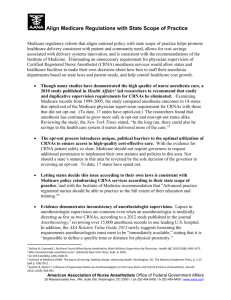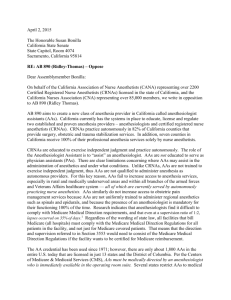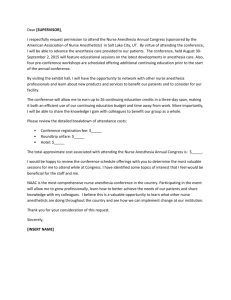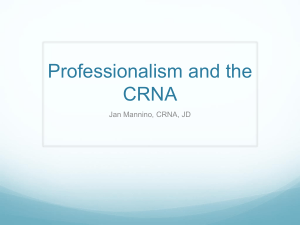CANA Talking Points - American Nurses Association – California
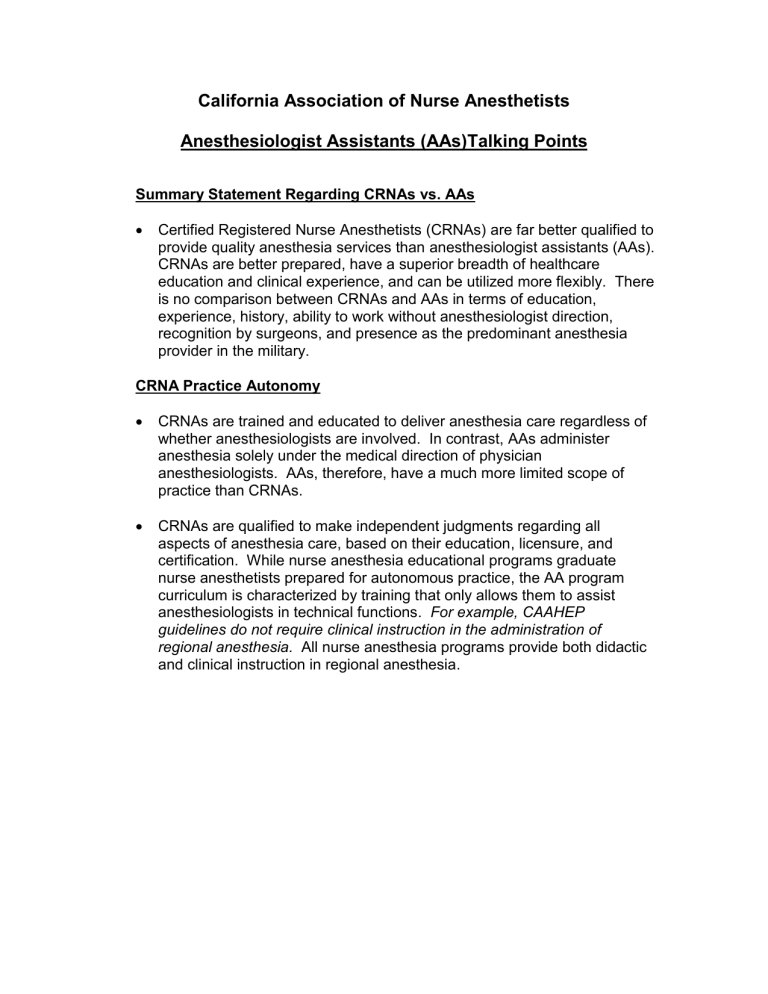
California Association of Nurse Anesthetists
Anesthesiologist Assistants (AAs)Talking Points
Summary Statement Regarding CRNAs vs. AAs
Certified Registered Nurse Anesthetists (CRNAs) are far better qualified to provide quality anesthesia services than anesthesiologist assistants (AAs).
CRNAs are better prepared, have a superior breadth of healthcare education and clinical experience, and can be utilized more flexibly. There is no comparison between CRNAs and AAs in terms of education, experience, history, ability to work without anesthesiologist direction, recognition by surgeons, and presence as the predominant anesthesia provider in the military.
CRNA Practice Autonomy
CRNAs are trained and educated to deliver anesthesia care regardless of whether anesthesiologists are involved. In contrast, AAs administer anesthesia solely under the medical direction of physician anesthesiologists. AAs, therefore, have a much more limited scope of practice than CRNAs.
CRNAs are qualified to make independent judgments regarding all aspects of anesthesia care, based on their education, licensure, and certification. While nurse anesthesia educational programs graduate nurse anesthetists prepared for autonomous practice, the AA program curriculum is characterized by training that only allows them to assist anesthesiologists in technical functions. For example, CAAHEP guidelines do not require clinical instruction in the administration of regional anesthesia.
All nurse anesthesia programs provide both didactic and clinical instruction in regional anesthesia.
2
Practice Location
CRNAs practice in every setting in which anesthesia is delivered: traditional hospital surgical suites and obstetrical delivery rooms; critical access hospitals; ambulatory surgical centers; the offices of dentists, podiatrists, ophthalmologists, plastic surgeons, and other medical professionals; and U.S. Military, Public Health Service, and Veterans
Administration healthcare facilities. CRNAs can provide anesthesia care anywhere it is needed, whether urban, rural or suburban.
Because AAs cannot practice without anesthesiologist supervision, AAs do not practice in rural areas where CRNAs working without anesthesiologist involvement are the primary providers of anesthesia care.
AAs, in contrast, can only practice where anesthesiologists practice, which gr eatly limits their utilization. AAs, therefore, can’t help solve problems of inadequate access to anesthesia care in rural and underserved communities.
If for any reason an AA’s supervising anesthesiologist is not available, offsite, on vacation, or simply home for the day, the AA may not provide anesthesia care. The AA anesthesiologist-driven mode of practice, therefore, is inflexible and fails to adequately meet the needs of patients, hospitals, ambulatory surgical centers, or other healthcare settings.
CRNA Professional Background Vs. AAs
AAs are not required to have any prior healthcare education or experience
(e.g., nursing, medical, anesthesia or healthcare education, licensure, or certification) before they begin their AA educational programs. CRNAs, in contrast, must have a bachelor’s degree, be a registered nurse, and have at least one year of acute care nursing experience prior to entering nurse anesthesia educational programs. CRNAs, unlike AAs, learn to assess and treat a broad range of health problems before even beginning anesthesia training.
Cost Effectiveness of CRNA Practice
Because CRNAs do not need to practice with an anesthesiologist, they are much more cost effective than AAs. With an AA, the need exists to educate and use two providers – the supervising anesthesiologist and the
AA
– to provide anesthesia care to one patient. With a CRNA, only that individual is needed to provide total anesthesia care to the patient.
Essentially, compared with the anesthesiologist-AA staffing arrangement, one CRNA can provide the care of two providers. A CRNA acting as the
3 sole anesthesia provider is the most cost-effective model for anesthesia delivery.
1
Provider Numbers
AAs are a fringe anesthesia provider of limited value in meeting patient anesthesia needs. There are approximately1800 AAs in the United States versus nearly 48,000 nurse anesthetists (including CRNAs and student registered nurse anesthetists). The fact that AAs have not proliferated despite being in existence for approximately 40 years is evidence of their limited value.
There is no shortage of anesthesia providers in California. The CA BRN reports there are 2,244 CRNAs licensed in CA (2013). The MBC reports there are 7,656 practicing anesthesiologists in CA. These figures do not include anesthesiology residents and fellows, nor do they include the nurse anesthesia student residents in five civilian California nurse anesthesia programs (Samuel Merritt University; Kaiser Southern
CA/CSU Fullerton; USC; Linda Loma University; and National University
Fresno), and two military programs (U.S. Navy in San Diego and U.S.
Army-Air Force in Fairfield/Travis Air Force Base). Thus there are nearly
10,000 licensed providers in the state at minimum. On average, approximately 30% of CA nurse anesthesia program graduates leave the state to seek their first position as a graduate nurse
anesthetists. (information comes directly from CA Nurse Anesthesia
Program Directors Poll, Karp, 2015).
National Authority to Practice
Every state authorizes CRNAs to provide anesthesia care; nurse anesthetists are explicitly recognized in state laws or regulations in all 50 states, and the District of Columbia. In contrast, AAs were explicitly recognized in state laws or regulations in only 14 states and the District of
Columbia.
1 See the 2010 study titled, “Cost Effectiveness Analysis of Anesthesia Providers.” [Hogan, P,
Seifert, R, Moore, C, Simonson, B. “Cost Effectiveness Analysis of Anesthesia Providers.”
Journal of Nursing Economic$.
May/June 2010. 28, No. 3. 159-169.] See also the AANA White
Paper titled, “Cost Effectiveness of Nurse Anesthesia Practice,” at http://www.aana.com/aboutus/Pages/Resources,-About-AANA.aspx
.
4
Louisiana passed legislation that has the effect of prohibiting AA practice, 2 declaring that
“CRNAs receive a much higher level of education and training than do AAs.”
3
Quality of Anesthesia Care
No peer-reviewed studies in scientific journals have been published regarding the quality of care of AA practice or AA anesthesia outcomes.
4
The quality of care that AAs provide is unproven, as there is no meaningful research data concerning AA anesthesia safety. In contrast, the excellent, safe anesthesia care that CRNAs provide and associated anesthesia outcomes have been repeatedly demonstrated in peerreviewed studies published in prominent journals.
5
Practice in the Military
CRNAs are the predominant anesthesia provider in the armed forces and the Veterans Affairs healthcare system. AAs are not authorized to work as anesthesia providers in the armed forces, and reportedly no Veterans
Affairs facilities have permanently hired AAs.
CMS Conditions of Participation/Reimbursement
The federal government, as reflected in Centers for Medicare & Medicaid
Services (CMS) rules, understands that CRNAs and AAs are not equivalent, and recognizes critical differences between the two providers.
The CMS-adopted Conditions of Participation that hospitals and ambulatory surgical centers must fulfill to participate in the Medicare and
Medicaid programs require AAs to work under anesthesiologist supervision.
2 Louisiana R.S. 37930 (G)(3), which states: “No health care provider or other person, other than a certified registered nurse anesthetist, physician, dentist, perfusionist, or other explicitly authorized provider, shall select or administer any form of anesthetic to any person either directly or by delegation unless explicitly authorized by this Title.
” Because AAs are not explicitly authorized to select or administer anesthesia under Louisiana law, this statute prohibits AAs from selecting or administering anesthesia.
3 Louisiana R.S. 37-930 (G)(1)(l).
4 A 2007 Kentucky legislative commission report stated: “No studies have been published in peerreviewed journals assessing the impact of anesthesiologis t assistants on patient safety …
Overall, the lack of data limits the conclusions that can be made about patient safety outcomes for anesthesiologist assistants.” Nothing has changed since 2007 to alter the Kentucky commission’s conclusion. See http://www.lrc.ky.gov/lrcpubs/RR337.pdf
. A Study of
Anesthesiologist Assistants . Research Report No. 337, Kentucky Legislative Research
Commission. February 2007. Pages 11-12.
5 See http://www.aana.com/resources2/professionalpractice/Pages/Professional-Practice-
Manual.aspx
> Quality of Care in Anesthesia. See also the AANA White Paper titled, “Quality of
Nurse Anesthesia Practice,” at http://www.aana.com/aboutus/Pages/Resources,-About-
AANA.aspx
.
5
In contrast, those Conditions of Participation generally require that
CRNAs work under physician supervision, but allow CRNAs to work without physician supervision in states that have opted out of the CMS physician supervision requirement. What this means is CMS does not require anesthesiologist supervision of CRNAs, and in many states does not require any physician supervision of CRNAs .
In fact, 17 states have opted out of the CMS physician supervision requirement for CRNAs.
6
The Center for Medicare and Medicaid Services (CMS) recently clarified and confirmed that anesthesiologist assistants (AAs) are prohibited from billing Medicare for non-medically directed services (billing code QZ). This is in contrast to CRNAS, who are authorized to bill Medicare directly for non-medically directed services. CMS clarified the distinctions between
CRNAs, who may practice autonomously, and AAs, whose must be medically directed by an anesthesiologist in order to bill Medicare.
This action clarifies what we already know: CRNA and AA educational preparation and services are not the same, and Medicare recognizes them differently. 7
AA Use and Competition
Increased use of AAs would set the stage for increased anesthesiologist control of the anesthesia marketplace
– and hence, less competition. This is because anesthesiologists have substantial control of AA practice, including education, accreditation, certification, clinical practice, payment, and employment. AAs cannot compete with anesthesiologists, because they cannot practice independent of anesthesiologist supervision. In contrast, because CRNAs are trained and educated to practice regardless of whether anesthesiologists are involved, CRNAs directly compete with anesthesiologists. If it were not for CRNAs, anesthesiologists would be able to have a monopoly over anesthesia care in the United States, which would drive up costs and reduce patient access to care, particularly in rural areas.
6 As of October, 2014, 17 states had adopted out of the federal supervision requirement (Iowa,
Nebraska, Idaho, Minnesota, New Hampshire, New Mexico, Kansas, North Dakota, Washington,
Alaska, Oregon, Montana, South Dakota, Wisconsin, California, Colorado, and Kentucky). For more information about opt-outs (such as all gubernatorial opt-out letters), go to http://www.aana.com/advocacy/stategovernmentaffairs/Pages/Federal-Supervision-Rule-Opt-
Out-Information.aspx
.
7 See CMS Policy Transmittal #2716 dated May 30, 2013, available at http://www.cms.gov/Regulations-and-Guidance/Guidance/Transmittals/Downloads/R2716CP.pdf
.
6
AAs will increase healthcare costs because two anesthesia providers are always necessary when the AA practices
– the AA and the anesthesiologist.
State Laws/Regulations
Many states do not require CRNAs to be physician supervised. Forty states do not have a physician "supervision" requirement for CRNAs in nursing or medical laws or regulations. If clinical "direction" requirements are considered in addition to "supervision," 32 states do not have a physician supervision or direction requirement for CRNAs in nursing or medical laws or regulations. Taking into account state hospital licensing laws or regulations as well, 33 states still do not require physician supervision.
7
Anesthesia Provider Supply
[ Note to state nurse anesthetist association leaders: You would use this talking point if a) opponents were arguing that there is an anesthesia provider shortage in your state and that AAs would help fill that gap; and b) you in fact can demonstrate that there is not a shortage. If there is a shortage, you could argue that nurse anesthetists are successfully addressing the problem, e.g., through expanding the number of graduates in nurse anesthesia programs in your state.]
There is no anesthesia provider shortage in this state. Further, restrictive state paw provisions can contribute to the shortage of anesthesia providers. It makes no sense to authorize AAs, a less qualified anesthesia provider that can only work with ane sthesiologists and can’t be used in any area where anesthesiologists don’t practice, such as many rural locations.
Updated October 2014
